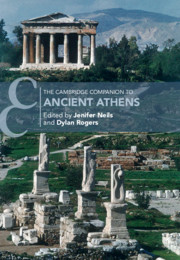Book contents
- The Cambridge Companion to Ancient Athens
- Cambridge Companions to the Ancient World
- The Cambridge Companion to Ancient Athens
- Copyright page
- Contents
- Contributors
- Abbreviations
- Athens: An Introduction
- 1 #Leagros: An Athenian Life
- Part I The Urban Fabric
- Part II Inhabitants
- Part III Business/Commerce
- Part IV Culture and Sport
- Part V Politics
- Reception
- 30 Roman Athens
- 31 Early Travelers and the Rediscovery of Athens
- 32 Modern Athens and Its Relationship with the Past
- 33 Urban Archaeology: Uncovering the Ancient City
- Index
- References
32 - Modern Athens and Its Relationship with the Past
from Reception
Published online by Cambridge University Press: 10 March 2021
- The Cambridge Companion to Ancient Athens
- Cambridge Companions to the Ancient World
- The Cambridge Companion to Ancient Athens
- Copyright page
- Contents
- Contributors
- Abbreviations
- Athens: An Introduction
- 1 #Leagros: An Athenian Life
- Part I The Urban Fabric
- Part II Inhabitants
- Part III Business/Commerce
- Part IV Culture and Sport
- Part V Politics
- Reception
- 30 Roman Athens
- 31 Early Travelers and the Rediscovery of Athens
- 32 Modern Athens and Its Relationship with the Past
- 33 Urban Archaeology: Uncovering the Ancient City
- Index
- References
Summary
In 1833, Athens became the capital of the newly created Kingdom of Greece after some 600 years of foreign domination. The creation of the new capital city from its ruins called upon the talents of local and foreign planners, architects, archaeologists, and philhellenes, who emphasized its Classical heritage and cultural achievements, often at the expense of the practicalities of government and the concerns of the local population.
- Type
- Chapter
- Information
- The Cambridge Companion to Ancient Athens , pp. 449 - 461Publisher: Cambridge University PressPrint publication year: 2021
References
Further Reading
For more on the development of architecture in modern Athens and Greece, see Tzonis and Rodi 2013. On the history and development of Athens as a city and capital of Greece, see Travlos 1981, Bastéa 2000, Papageorgiou-Venetas 2001 (in Greek, but well illustrated), and Beaton 2019 (with previous bibliography); further, see Hamilakis 2007 on the relationship between modern Greece and its ancient past. See Scully 1963 for an entertaining exploration of the relationship between Kleanthes and the Duchess of Plakentias. The Akropolis in the nineteenth century has been presented by Carter 1979 and Tomlinson 1987. The work of Danish architects in Athens in the nineteenth century has been explored by Bendtsen 1993 and Cassimatis and Panetsos 2014 (in Greek), along with Kardamitsi-Adami 2006 on the architecture of Ziller. Biris and Kardamitsi-Adami 2005 offers a lavishly illustrated introduction to Neoclassical architecture in Greece. Dumont 2020 explores the neighborhood of Vrysaki in Plaka that was razed with the start of the excavations of the Athenian Agora in 1931.
Bibliography
Additional resources to accompany this chapter can be found at: www.cambridge.org/NeilsRogers

